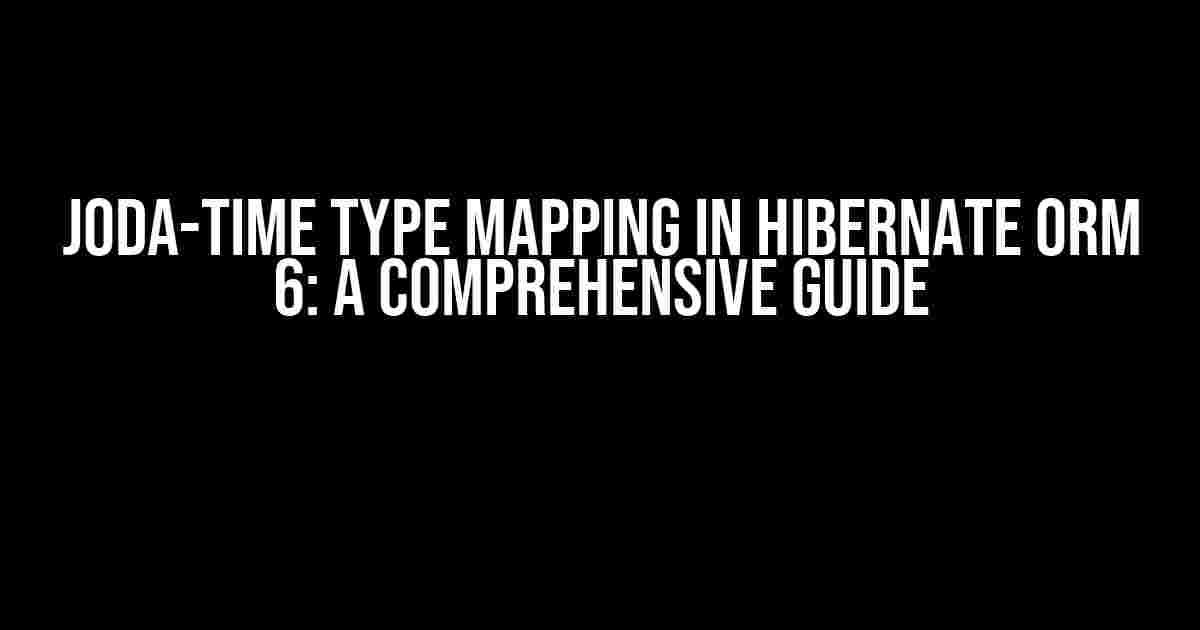Are you tired of dealing with date and time-related issues in your Hibernate-based application? Look no further! In this article, we’ll explore the nuances of Joda-time type mapping in Hibernate ORM 6, and provide you with a step-by-step guide to implement it seamlessly.
What is Joda-time?
Joda-time is a popular Java library used for working with dates and times in Java applications. It provides a more comprehensive and intuitive API for handling date and time-related operations compared to the built-in Java date and time classes. Joda-time has been widely adopted in the industry due to its flexibility, accuracy, and ease of use.
Why Use Joda-time with Hibernate?
Hibernate, being an ORM (Object-Relational Mapping) tool, allows developers to interact with databases using Java objects. However, when it comes to date and time-related fields, Hibernate’s built-in support can be limited. This is where Joda-time comes into play.
- Joda-time provides a more comprehensive set of date and time classes, including
DateTime,LocalDate, andLocalDateTime, which can be used to model complex date and time-related data. - Joda-time offers improved performance and efficiency compared to Hibernate’s built-in date and time handling.
- By using Joda-time with Hibernate, you can take advantage of Joda-time’s advanced features, such as support for multiple time zones, durations, and periods.
Configuring Joda-time Type Mapping in Hibernate ORM 6
To use Joda-time with Hibernate ORM 6, you’ll need to configure the type mapping. Here’s a step-by-step guide to help you get started:
Step 1: Add Joda-time Dependencies
Add the following dependencies to your project’s pom.xml file (if you’re using Maven) or your build.gradle file (if you’re using Gradle):
<dependency>
<groupId>joda-time</groupId>
<artifactId>joda-time</artifactId>
<version>2.10.10</version>
</dependency>
<dependency>
<groupId>org.jadira.usertype</groupId>
<artifactId>jadira-usertype-core</artifactId>
<version>7.0.0.CR1</version>
</dependency>
Alternatively, you can download the Joda-time and Jadira Usertype libraries and add them to your project’s classpath manually.
Step 2: Configure Type Mapping
Create a new Java class that will serve as the type mapping configuration class:
public class JodaTimeTypeMapping {
@Override
public void contribute(TypeContributions contributions, ServiceRegistry serviceRegistry) {
contributions.contributeType(new JadiraUsertypeDateTimeType());
contributions.contributeType(new JadiraUsertypeLocalDateType());
contributions.contributeType(new JadiraUsertypeLocalDateTimeType());
}
}
This class contributes three type mappings to Hibernate:
JadiraUsertypeDateTimeType: Maps Joda-time’sDateTimeclass to Hibernate’sTimestampType.JadiraUsertypeLocalDateType: Maps Joda-time’sLocalDateclass to Hibernate’sDateType.JadiraUsertypeLocalDateTimeType: Maps Joda-time’sLocalDateTimeclass to Hibernate’sTimestampType.
Step 3: Register the Type Mapping Configuration
In your Hibernate configuration file (hibernate.cfg.xml or hibernate.properties), add the following property:
<property name="hibernate.type_contributions">joda.time_mapping.JodaTimeTypeMapping</property>
This registers the JodaTimeTypeMapping class as the type contributor for Hibernate.
Step 4: Use Joda-time Types in Your Entities
Now that the type mapping is configured, you can use Joda-time types in your Hibernate entities:
@Entity
public class Event {
@Id
@GeneratedValue(strategy = GenerationType.IDENTITY)
private Long id;
@Column(nullable = false)
private DateTime startDate;
@Column(nullable = false)
private LocalDate endDate;
// Getters and setters
}
In this example, the Event entity uses Joda-time’s DateTime and LocalDate classes to model the start and end dates.
Benefits of Using Joda-time with Hibernate ORM 6
By using Joda-time with Hibernate ORM 6, you can:
- Take advantage of Joda-time’s advanced date and time features, such as support for multiple time zones and durations.
- Improve performance and efficiency in date and time-related operations.
- Simplify date and time-related business logic using Joda-time’s intuitive API.
- Future-proof your application by using a widely adopted and well-maintained date and time library.
Conclusion
In this article, we’ve explored the benefits of using Joda-time with Hibernate ORM 6 and provided a step-by-step guide to configure Joda-time type mapping. By following these instructions, you can unlock the full potential of Joda-time and Hibernate, and build more robust and efficient date and time-related applications.
| Library | Version | Dependency |
|---|---|---|
| Joda-time | 2.10.10 | <dependency> <groupId>joda-time</groupId> <artifactId>joda-time</artifactId> <version>2.10.10</version> </dependency> |
| Jadira Usertype | 7.0.0.CR1 | <dependency> <groupId>org.jadira.usertype</groupId> <artifactId>jadira-usertype-core</artifactId> <version>7.0.0.CR1</version> </dependency> |
Remember to update the dependency versions accordingly based on your project’s requirements.
Happy coding!
Frequently Asked Question
Get ready to master Joda-time type mapping in Hibernate ORM 6! Here are the top 5 questions and answers to get you started.
What is Joda-time and why is it used in Hibernate?
Joda-time is a popular Java library for working with dates and times. Hibernate uses Joda-time to provide a more comprehensive and flexible way of handling date and time-related data types in Java applications. With Joda-time, Hibernate can accurately convert and store dates and times in a database, ensuring consistency and precision.
How do I enable Joda-time support in Hibernate ORM 6?
To enable Joda-time support in Hibernate ORM 6, you need to add the Joda-time dependency to your project’s pom.xml file (if you’re using Maven) or your build.gradle file (if you’re using Gradle). You also need to register the Joda-time dialect in your Hibernate configuration file (hibernate.cfg.xml or hibernate.properties).
What are the available Joda-time types in Hibernate ORM 6?
Hibernate ORM 6 supports several Joda-time types, including DateTime, DateMidnight, LocalDateTime, Instant, and Duration. These types allow you to work with dates and times in a more flexible and precise way, including support for time zones, daylight saving time adjustments, and more.
How do I map a Joda-time type to a database column in Hibernate?
To map a Joda-time type to a database column in Hibernate, you can use the `@Type` annotation on your entity field or property. For example, you can use `@Type(type = “org.jadira.usertype.dateandtime.joda.PersistentDateTime”)` to map a `DateTime` field to a database column. You can also use the `@ColumnType` annotation to specify the database column type.
Are there any known limitations or issues with using Joda-time in Hibernate ORM 6?
Yes, there are some known limitations and issues with using Joda-time in Hibernate ORM 6. For example, Joda-time may not work correctly with certain database types or providers. Additionally, Joda-time may not provide the same level of precision as Java’s built-in `java.time` package. Be sure to check the Hibernate documentation and Joda-time release notes for the latest information on known issues and limitations.

